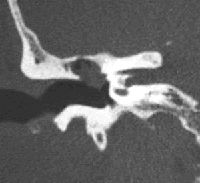CT image of a cholesteatoma

Cholesteatoma
WHAT IS A CHOLESTEATOMA? HOW CAN IT BE TREATED?
If left untreated, it can lead to serious complications, including:
- initially, hearing impairment and discharge with a distinctive unpleasant smell;
- vertigo and complete and irreversible hearing loss(if the cholesteatoma spreads to the middle ear);
- facial paralysis, if it compresses the nerve controlling facial movements;
- meningitis and brain abscesses, if it destroys the upper wall of the ear and spreads to brain structures.
Its progression is usually (though not always) slow. Since it does not cause the patient to feel any pain, as the discharge only occurs at the beginning, some patients do not visit an ENT (ear, nose and throat) specialist until they experience the effects of the cholesteatoma and its complications.
Cholesteatoma always requires surgical treatment by means of a tympanoplasty. The cholesteatoma is fully removed by means of microsurgery. The tympanoplasty has a success rate of 90% and the sooner it is performed, the better the results.
Cholesteatoma tends to reproduce, therefore patients must be monitored for a number of years through yearly or six-monthly check-ups.
In addition to completely removing the cholesteatoma, the operation aims to preserve as much of the patient’s remaining hearing as possible and, if possible, to restore any hearing loss. This is achieved by reconstructing the ossicles of the middle ear (ossiculoplasty), although this is not always an option.